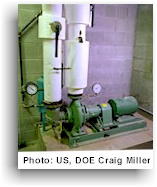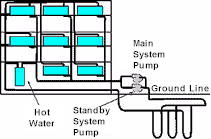

Applications
Savings
Benefits
Costs
Maintenance
 |
Geothermal heat pumps, also known as ground source heat pumps, are similar to ordinary air conditioners and heat pumps, but they dump building heat into or extract heat from the ground rather than the outside air. The tempering effect of the earth (or a body of water) provides for either heat extraction or heat rejection, allowing ground source heat pumps to perform more efficiently than conventional equipment in particularly hot or cold climates. Ground source heat pump systems are known by many different names, such as geothermal, ground-coupled, or GeoExchange systems. |
All of these systems consist of a "groundloop" for exchanging heat with soil, groundwater, surface water, wastewater streams, or potable water supplies. In most systems, the heat exchanger consists mainly of long pipes either placed in vertical well bores or, if land is available, buried in horizontal trenches. If there is a body of water nearby with adequate depth to maintain a somewhat stable temperature, a coil can be dropped into that water to exchange heat. One or more heat pumps are then connected to this ground loop to provide indoor space heating and cooling. Some systems provide water heating as well.
Vertical bores generally average 400 feet in length per ton of capacity. Horizontal trenches average 600 to 1,000 feet per ton, depending on soil type. Most systems are closed loop but some are an open loop, whereby water is pumped through the ground source heat pump and then re-injected into the ground or into surface water.
Applications
Ground source heat pumps can be applied to virtually any size commercial building as well
as specialized applications such as swimming pools. Ground source heat pumps tend to be
the most cost effective in the following applications:
- New construction
- Climates where winters are quite cold and/or summers quite hot
- Areas of high electricity costs (greater than $0.07/kWh)
- Areas where natural gas is unavailable or where cost is high compared with electricity.

Horizontal trenches require more available land space than vertical bores. When considering an open-loop system, check with local environmental authorities to ensure compliance with regulations.
There are one-to-two-million ground source heat pumps operating in homes, schools, and commercial buildings in the United States. The only remaining barriers to further rapid implementation of ground source heat pumps involve lack of user awareness/acceptance and higher implementation cost. These barriers are being reduced with the help of a number of government agencies, utilities, and other organizations.
Savings
Ground source heat pump energy cost savings vary with the electric rates, climate loads,
soil conditions, and other factors. In commercial building applications, typical energy
savings are in the range of 45 and 70 percent compared to conventional HVAC equipment.
Maintenance costs are reported to be half that of conventional heating and air
conditioning systems.
Benefits
The primary benefit of ground-source heat pumps is the increase in operating efficiency,
which translates to reduced heating and cooling costs, but there are additional
advantages. An environmental benefit is that ground-source heat pumps typically use 25%
less refrigerant than split-system air-source heat pumps or air-conditioning systems.
Interior space requirements are also reduced. There are no floor space requirements for
boilers or furnaces, just for the unitary systems and circulation pumps.
Compared with air-source heat pumps that use outdoor air coils, ground-source heat pumps do not require defrost cycles or crankcase heaters and there is virtually no concern for coil freezing. Another benefit is quieter operation, because ground-source heat pumps have no outside air fans. Finally, ground-source heat pumps are reliable and long-lived, because the heat pumps are generally installed in climate-controlled environments and therefore are not subject to the stresses of extreme temperatures.
Costs
The complete cost of a commercial ground source heat pump ranges from $3,800 to $5,200 per
ton. This cost includes multiple heat pumps, ground loop, inter-connections, pumps,
controls, and ducting. For a cooling-dominated commercial building, the capacity needed is
usually one ton of capacity per 350 to 400 square feet. When simply looking at the initial
cost of a single ground source heat pump unit over an air-source heat pump unit, a 20%
premium will usually apply.
Maintenance
System maintenance on a ground source heat pump is often less than conventional systems
and estimated at five to ten cents per square foot of conditioned space per year. The
actual cost will vary with:
- Type of heat pump (one central unit or many smaller heat pumps connected in a loop)
- Type of ground loop (horizontal or vertical)
- Ground conditions (how difficult drilling is, how deep the holes need to be)
- Experience of the contractor. Those with less experience in the geographic area may charge more to cover their risk factor
Source: U.S. DOE, Federal Energy Management Program Technology Brief and Alert: Ground Source Heat Pumps for Commercial Applications
|
|

|
| THE CONTENT OF THIS LIBRARY HAS NOT BEEN APPROVED OR ENDORSED BY DUKE POWER AND MAY NOT REFLECT DUKE POWER'S VIEWS OR POSITIONS ON THE SUBJECT MATTER CONTAINED THEREIN. Copyright Aclara Technologies LLC. All Rights Reserved. | |